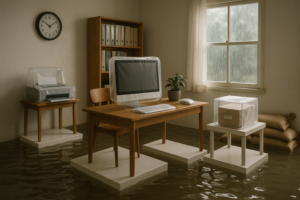Basement flooding during heavy rain is a problem that should scare every homeowner, particularly in areas where sudden downpours can overwhelm drainage systems and lead to water intrusion.
The common causes of such flooding range from poor drainage around the home to foundation cracks and sewer backups. Understanding and addressing these issues proactively can save Austin area homeowners considerable stress and costly repairs.
In this blog post, we’ll walk you through the crucial steps you need to take to keep your basement dry, underscoring the importance of being proactive.
What Causes Basement Flooding?
Do you wonder, “Why do my drains back up when it rains?” The issue usually stems from a few critical areas. Poorly designed or clogged drainage systems can lead to water pooling around the foundation. Over time, this can cause or exacerbate cracks in the foundation, through which water can seep into basements.
Additionally, municipal sewer systems can become overwhelmed during heavy rainfall, resulting in sewer backups into homes. This is particularly problematic in systems that handle both sewage and stormwater.
Understanding these root causes—inefficient drainage, foundation vulnerabilities, and sewer system limitations—will allow you to take focused actions, such as cleaning gutters, repairing cracks, or installing backwater valves to prevent flooding and protect your home.
Assessing and Improving Drainage Systems
A critical step in preventing basement flooding is ensuring your home’s drainage systems are up to par. Homeowners should regularly inspect and maintain their gutters, downspouts, and the grading around their home’s foundation to ensure water is directed away from the house.
It’s important to clear any blockages and repair any parts of the drainage system that are not functioning properly to prevent water from pooling around the basement, which can lead to seepage and flooding.
Clogged Sewer Drain in Basement: Identifying and Resolving Issues
Several distinct symptoms can indicate a clogged sewer drain in a basement, indicating that immediate action may be necessary to prevent flooding and potential damage.
Here are the key signs to watch for:
- Slow Draining: If water drains more slowly than usual from your basement fixtures, it could be a sign of a clog forming in the sewer line.
- Water Backup: One of the most obvious signs is water backing up out of drains or toilets in the basement. This usually happens first in the lowest points of your home because they’re closest to the clog.
- Gurgling Sounds: Unusual noises from your drains, like gurgling or bubbling sounds, can indicate that air is trapped and being pushed back up the system due to a blockage.
- Foul Odors: A distinct, unpleasant odor emanating from basement drains strongly indicates a sewer line blockage. This smell is caused by waste material that can no longer pass through the sewer line.
- Multiple Fixtures Are Clogged: When more than one plumbing fixture backs up simultaneously, it’s a clear sign that the problem is not with a single drain but rather with the main sewer line.
- Changes in Toilet Water Level: If the water level in your toilets fluctuates significantly or if you notice that flushing one toilet causes water to rise in another drain or toilet, it could indicate a sewer drain clog.
- Sewage in Floor Drain: In severe cases, you might see actual sewage coming up through the floor drains, indicating a significant blockage in the sewer line.
To tackle a clogged sewer drain in your basement effectively:
- Plunge affected drains to dislodge simple blockages.
- Use a drain snake for more challenging clogs deeper in the line.
- Apply enzyme-based cleaners regularly to break down organic buildup.
- Seek professional inspection if DIY methods fail to identify the exact issue with a camera.
- Opt for professional sewer line cleaning or jetting to remove severe blockages.
- Investigate tree roots with a professional who can remove them and repair pipes as needed.
- Install a backwater valve to prevent future sewage backups, which is particularly useful in heavy rain areas.
Quick action and the right approach can prevent further damage and keep your basement dry and healthy.
Waterproofing Basement Walls and Floors
Waterproofing your basement is key to preventing flooding, a concern especially in rainy areas like Austin. This summary outlines several methods to protect your basement from water damage:
Interior Methods:
- Sealants and Coatings: Apply waterproof products to interior basement surfaces to block leaks and moisture.
- Epoxy Injections: Seal cracks in concrete walls to prevent water entry.
- Interior Drainage Systems: Install systems to catch water inside the basement and pump it out, keeping the area dry.
Exterior Methods:
- Exterior Coatings: Apply waterproof layers to the outside basement walls, often involving digging around the house for thorough protection.
- French Drains: Place drains around the foundation to carry water away, suitable for Austin’s unique soil.
- Gutter and Downspout Maintenance: Ensure your home’s gutters and downspouts are correctly installed and functioning to direct roof runoff away from the foundation, reducing the risk of water seeping into the basement.
Installing Sump Pumps for Added Protection
Sump pumps are vital in preventing basement flooding by pumping out water that accumulates in the sump pit. For homes in areas prone to heavy rain, such as Austin, selecting the right sump pump, installing it correctly, and maintaining it are essential steps. These devices can be lifesavers, keeping basements dry during severe weather events.
Landscaping Tips to Direct Water Away from the Home
Smart landscaping can also help direct rainwater away from the foundation, reducing the risk of basement flooding. Techniques such as installing rain gardens, swales, and French drains not only help manage water runoff but can also enhance the beauty of your property. It’s crucial to ensure the land around your home slopes away from the foundation, guiding water to flow away from, rather than towards, your home.
Final Thoughts
For homeowners in the Austin area, taking proactive measures to prevent basement flooding is crucial. Understanding the common causes and implementing strategies such as improving drainage systems, waterproofing, and installing sump pumps can significantly reduce the risk of water damage during heavy rain. Regular maintenance and vigilance can save a lot of trouble and expense in the long run.
Call All Nation Restoration
If you experience basement flooding or water damage despite your best preventive measures, don’t hesitate to contact All Nation Restoration. We offer professional remediation services to help protect your home from further damage. Schedule a consultation today. Protect your home and peace of mind by being prepared for whatever the weather brings.







